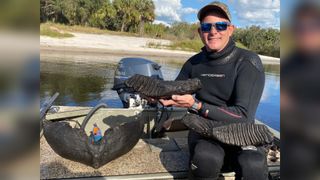
John Kreatsoulas pulled the mammoth jaw up from the Peace River in Florida while diving for fossils.
(Image credit: John Kreatsoulas/fossiljunkies.com)
A fossil hunter made an astonishing discovery while diving in a Florida river — the fossilized jawbone of a mammoth.
John Kreatsoulas, who runs Fossil Junkies Dig and Dive Charters, an organization that runs fossil-hunting trips for the public, discovered the intact fossil while exploring a section of the Peace River near the city of Arcadia.
He initially thought the item was a log, but on closer inspection, realized it was a large mandible.
Kreatsoulas doesn’t know exactly how old the specimen is, but believes it could be at least 10,000 years old.
The mammoth jaw is at least 10,000 years old. (Image credit: John Kreatsoulas/fossiljunkies.com)
“I grabbed onto it just to hold on for a second, and I realized — ‘wait for a second, that’s not a tree, that was a mammoth jaw,'” he told NBC2, a local Florida outlet.
Related: Dwarf elephants and shedding mammoths shine at NYC’s ‘Secret World of Elephants’
Kreatsoulas is planning to take the jawbone to be cleaned and analyzed by experts in Tampa, who will be able to determine the fossil’s age with radiocarbon dating. This is where researchers determine the levels of particular radioactive elements — often radiocarbon or potassium — in a fossil to work out when a rock was formed or when an animal died. The bone will also be registered with the State of Florida, so it may end up in a museum rather than in Kreatsoulas’ personal collection at home.
It’s not known exactly what kind of mammoth the fossil belonged to, but Columbian mammoths (Mammuthus columbi) inhabited North America — and as far south as Costa Rica — during the Pleistocene epoch (2.6 million years to 11,700 years ago).
The Columbian mammoth was likely a hybrid between the woolly mammoth (Mammuthus primigenius) and an unknown lineage of mammoth that arrived in North America from Siberia around 1.5 million years ago, according to DNA research.
Columbian mammoths went extinct between 13,000 and 10,000 years ago, at the end of the last ice age. Warmer temperatures caused a loss of habitat for these megafauna, which combined with humans hunting led to huge population declines.
This isn’t the first time mammoth fossils have been found in Florida’s Peace River. In 2021, divers discovered a 4-foot (1.2 meters) mammoth leg bone in the water. Meanwhile, in northern Florida, researchers have unearthed a 5.5 million-year-old “graveyard” of gomphotheres, a four-tusked relative of modern elephants, that had likely drowned in a prehistoric river there.
Stay up to date on the latest science news by signing up for our Essentials newsletter.
Lydia Smith is a health and science journalist who works for U.K. and U.S. publications. She is studying for an MSc in psychology at the University of Glasgow and has an MA in English literature from King’s College London.
>>> Read full article>>>
Copyright for syndicated content belongs to the linked Source : Live Science – https://www.livescience.com/animals/extinct-species/huge-mammoth-jaw-at-least-10000-years-old-pulled-up-from-florida-river
